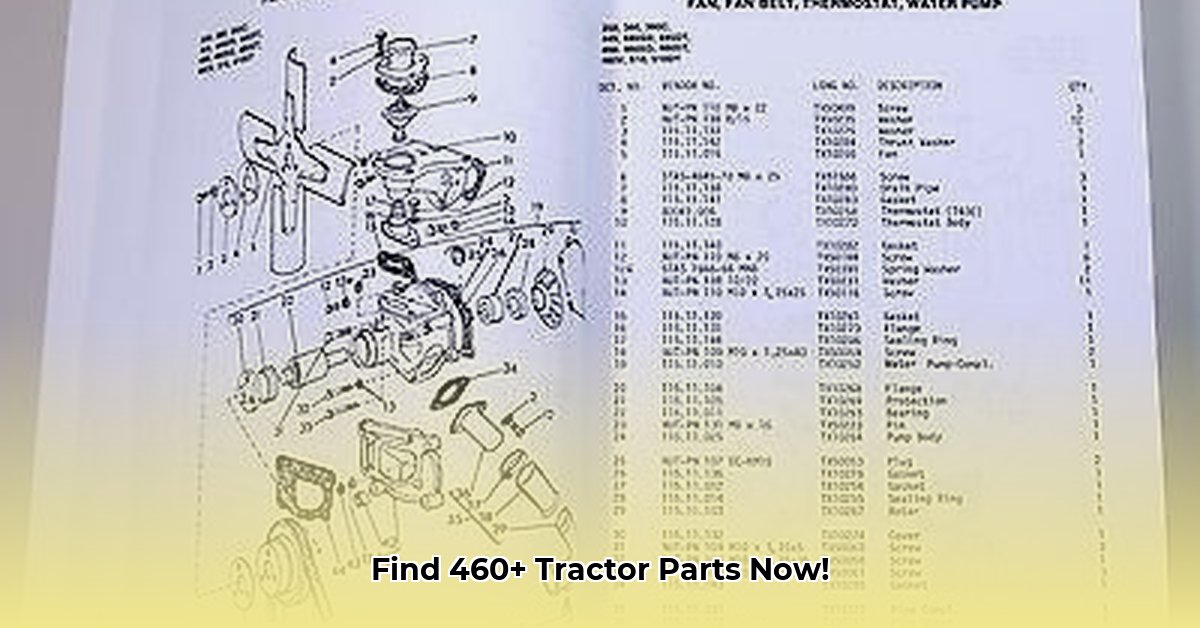
Finding parts for your trusty Long 460 tractor shouldn't be a Herculean task. This comprehensive guide navigates the complexities of sourcing, maintenance, and repair, equipping you with the knowledge to keep your machine running smoothly. Whether you're a seasoned mechanic or a novice tractor owner, we've got you covered. For more information on large tractors, check out this helpful resource: Large Tractor Resources.
Understanding Your Long 460: A Quick Overview
Before diving into parts, let's familiarize ourselves with your 460 Long. Understanding its major components—engine, transmission, hydraulic system, etc.—simplifies troubleshooting and part identification. Regular checkups (like a doctor's visit) prevent minor issues from escalating into costly repairs. What are some common problems you've experienced with your 460 Long? Knowing this helps us prioritize essential parts.
Sourcing 460 Long Tractor Parts: Your Strategic Plan
Locating parts for older tractors requires a multi-pronged approach. Here’s your action plan:
The Online Marketplace: Your Digital Parts Store
Top 5 Online Retailers for Long 460 Parts: Numerous online retailers specialize in agricultural equipment parts. We recommend comparing prices, shipping times, and reading customer reviews before committing to a purchase. Look for vendors offering detailed parts diagrams. Do you always choose the cheapest option? Why or why not? (Consider factors like quality and warranty.)
Targeted Online Searches: Precision is key! Use the exact part number whenever possible. Vague terms lead to irrelevant results. Is it a single component or an entire assembly? Specify your needs for more accurate results.
Local Expertise: Leveraging Your Network
Local Tractor Repair Shops: These shops often stock parts or know where to find them, providing valuable local expertise and personalized advice. They are also a great resource for troubleshooting tips. Did you know that many local shops offer repair services as well?
Connecting with Fellow 460 Long Owners: Networking through local agricultural groups or online forums can connect you with others facing similar challenges. Their experiences and knowledge can save you time and money. Has your network ever helped you solve a tractor problem?
Alternative Sourcing Options: Exploring Other Avenues
Used or Reconditioned Parts Market: This can be a cost-effective option, but thorough inspection is critical before installation. How do you ensure the quality of a secondhand component? (Consider examining it for wear and signs of prior damage.)
Online Tractor Communities: Online forums dedicated to classic tractors are invaluable resources for information and part sourcing. They're a great way to learn from others' experiences. Have you ever consulted an online tractor community for advice?
Aftermarket Parts: Weighing the Trade-offs
OEM (Original Equipment Manufacturer) and aftermarket parts differ in cost, availability, quality, and warranty. Choose wisely, considering your budget and risk tolerance.
| Feature | Aftermarket Parts | OEM Parts |
|---|---|---|
| Cost | Generally lower | Typically higher |
| Availability | Usually higher | Potentially lower, especially for older models |
| Quality | Variable; research is crucial | Generally higher |
| Warranty | Variable; check carefully | Usually better |
Preventative Maintenance: Prolonging Your Tractor's Life
Preventative maintenance is far more cost-effective than emergency repairs. A simple checklist ensures your 460 Long runs smoothly:
- Regular Fluid Checks: Monitor and replenish engine oil, transmission fluid, coolant, and hydraulic fluid. (Think of these fluids as the lifeblood of your tractor.)
- Belt and Hose Inspections: Regularly check for wear and tear. Replacing worn belts prevents catastrophic failures. (Worn belts compromise power transmission and can cause serious damage.)
- Lubrication: Consult your owner's manual for recommended lubrication points. Lubrication minimizes friction and extends component lifespan.
- Regular Cleaning: Remove dirt and debris to prevent damage to sensitive components. (Dirt and grime can accelerate wear on moving parts and cause damage.)
Troubleshooting and Common Repairs: Addressing Potential Issues
Even with preventative maintenance, issues arise. Here are some common problems and potential solutions:
- Engine Problems: Starting difficulties or lack of power can indicate fuel system, ignition, or engine issues.
- Transmission Issues: Difficult shifting might signal transmission problems. (Consult your owner's manual or seek professional help for transmission repairs.)
- Hydraulic Problems: Leaks or slow response require professional attention. (Hydraulic systems are complex and require specialized knowledge for repair.)
A detailed troubleshooting checklist is invaluable; consult your owner's manual or online resources.
Advanced Repair Techniques (For Experienced Users)
More complex repairs require specialized knowledge and tools. Always prioritize safety; consult your manual or seek professional assistance.
Conclusion
Mastering parts sourcing and preventative maintenance ensures your 460 Long's longevity. By using the strategies outlined here, you can conquer the challenges of maintaining your tractor and keep it running for years to come.